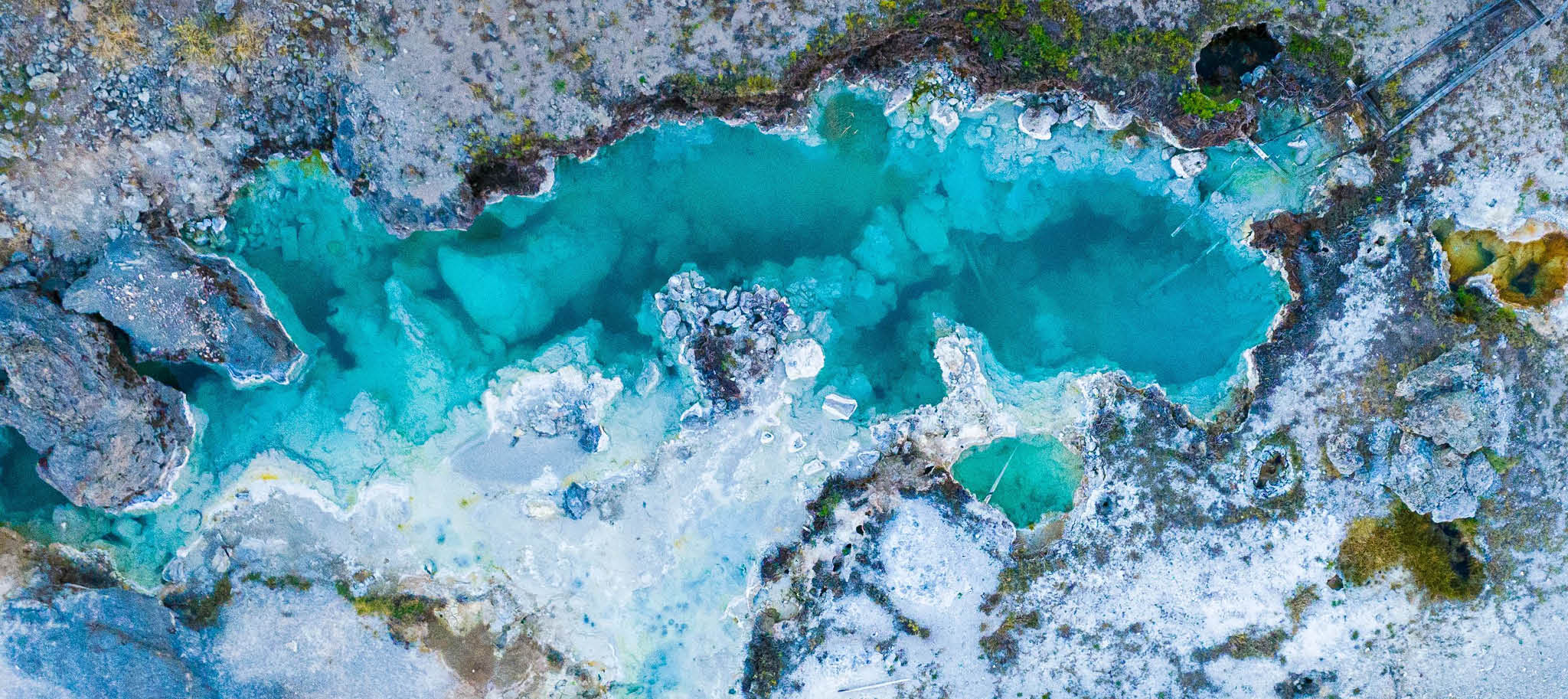Geothermal energy is thermal energy stored and created through radioactive decay beneath the Earth’s crust. It’s virtually infinite from a human perspective, estimated to be 3.15 × 1015 TW.h or the equivalent of 20 billion years of energy consumption (based on 2022 rates). Geothermal energy is also extremely low in terms of greenhouse gas (GHG) emissions, has a very small footprint surface-side, and is available 24 hours a day, 365 days a year.
Yet, with 17.5GWe of power and 16.5 GWth of heating capacity installed worldwide, geothermal energy represents less than 0.5% of our energy sources. Why has its use been limited thus far and, more importantly, how can it be unlocked to play a larger role in the energy mix?
The promise of enhanced geothermal systems
To date, we’ve used geothermal heat primarily by extracting high-temperature water or steam from the subsurface. This activity requires very particular geological settings, where the water or steam is trapped in large fractures under caprock, typically in regions of magmatism or at tectonic plate boundaries. Only a limited number of locations have the three conditions necessary for efficiently producing electricity from geothermal sources:
- High formation temperatures of 150 degC [302 degF] or more
- The presence of water, steam, or both in large quantities
- High-permeability formations such as fractures (producing significant amounts of power requires flow rates of 50,000 bbl/d or more).
The temperature can be lower for direct use of subsurface heat, such as district heating, agriculture, aquaculture, etc. In fact, deep sedimentary aquifers have already been used to produce heat in the Paris Basin, Munich Basin, other places in Europe, and China.
An enhanced geothermal system (EGS), on the other hand, uses stimulation to create a vast reservoir or heat exchanger, thereby enabling us to capture heat from the subsurface over an extended (potentially infinite) period of time. All of this is achieved without drilling through a water or steam reservoir, or a region of adequate permeability.
Because of the very low thermal conductivity of rock, the heat exchange surface and volume must be very large (of the order of km² and km³, respectively) to sustain multiyear production. To achieve the same sustained performance, advanced geothermal systems ask that you drill at much longer intervals. The Eavor-Loop™ 2.0 (a mark of Eavor Technologies Inc.), for example, consists of 2 wells with 12 laterals each intercepting at their end and reaching the incredible drilling length of more than 80km.
The potential regions of applicability are virtually unlimited, mostly because EGS only requires temperatures in the range of 225–250 degC [437–482 degF]. The US Office of Energy Efficiency & Renewable Energy’s GeoVision analysis evaluates EGS potential at 4.25 TWe versus 28 GWe for identified and undiscovered hydrothermal resources in the US. A reasonable extrapolation to 50 TWe worldwide corresponds to 2.5 times the average power consumed in 2022 from electrical and other sources.
The concept of EGS is not new, so why now?
The first attempt to artificially stimulate a low-permeability resource was using thermal and hydraulic stimulation of a well intercepting fractures in Iceland’s Mosfellssveit region in 1970. Three years later, multiple fractures intercepting an injector and producer well were created in Fenton Hill, New Mexico. Keep in mind that these research programs were probably low funded, with little to no access to state-of-the-art tools and tech.
Fast forward to today and you’ll see interest in geothermal energy reigniting. With the need for resilient, stable power sources to complement intermittent solar and wind energy—along with the world’s focus on achieving carbon neutrality by 2050—the industry is poised for a big breakout. The US Department of Energy has prioritized research in this field and financed the Wells of Opportunity program. Among participants is the Utah Frontier Observatory for Research in Geothermal Energy (FORGE), which not only operates as an EGS research site but also collaborates with geothermal operators on projects converting low-producing assets to EGS. The hydrocarbon industry is also actively participating in these programs, testing and improving its tech to meet the unique demands of geothermal wells and developments. After all, it’s subsurface knowledge applied to subsurface needs—a perfect fit.
One could even draw a parallel with the shale oil and gas revolution in the US, triggered by the Energy Policy Act of 2005. At that time, not many believed in the likelihood of producing unconventional resources at a competitive price, and yet today, the average price of production is about USD 21 per barrel of oil equivalent—less than a quarter of what it was 10 years ago. In the same way, EGS should benefit from incentives that pave the way toward reaching a competitive levelized cost of energy. In addition, as geothermal is a baseload (meaning it delivers a stable source of power 100% of the time), it should enjoy the bonus of a higher selling price, no?
The hurdles to overcome
Drilling long laterals and stage fracturing are key to enhanced geothermal systems, but the associated costs are significant. That said, if things evolve the same way they did for unconventional oil and gas, EGS will become an extremely competitive source of energy.
The vast majority of EGS resources will be basement rock (igneous rocks, such as granite) and some metamorphic rocks. All are extremely hard compared to the sedimentary rocks encountered in oil and gas wells. The target zones will typically also be much more homogeneous (not layered), hotter, deeper (under more compressive stress), and therefore less fractured or potentially more complicated to fracture.
In other words, the oil and gas industry cannot assume it will be able to use its portfolio of products and solutions to address all these challenges. We will also have to:
- Drill long horizontal wells in very hard and abrasive rock with high rate of penetration (ROP) and bit durability: Ideally, we would match the ROP (105 ft/h) and bit life (single bit for the entire horizontal section) achieved in unconventional oil and gas wells. In 2012, the average ROP in unconventional plays was 34 ft/h, very similar to ROPs achieved recently by Utah FORGE using polycrystalline diamond compact (PDC) cutters. Alternate technologies (such as hammer drilling and particle-jet-assisted drilling) have proven unsuccessful, while PDC bits keep beating their own records as new designs are released. It’s likely that enhancing the thermal capabilities (to resist heat generated from friction), cutting profiles, and materials of this tech will enable efficient drilling in hard rocks.
- Maintain bottomhole assembly (BHA) and logging tool temperatures within specifications: Excellent results in maintaining the drilling BHA at a low temperature (typically 150 degC or 302 degF) have been achieved at Utah FORGE thanks to insulated drillpipe and mud cooling. Use of through-the-bit logging services allows circulation while logging, which also helps maintain the tool temperature within its envelope of operation. Most likely, there’s no need for additional tech developments to address this challenge.
- Create a homogeneous fracture network between injector and producer wells: To enable sustained production over the asset’s life (possibly 30+ years), the spacing between the injector and producer wells, distance between fractures, and surface area of the fractures must be optimized. Igneous and metamorphic rocks have much higher compressive strength, and the network of natural fractures seems to influence fracture propagation (as seen in microseismic imaging).
It will be crucial to develop an accurate fracturing model and natural fracture map to properly plan and optimize each job. Techniques may have to be developed or improved to conduct seismic or microseismic mapping in formations with high acoustic contrast with near-surface formations. Proppant usage or alternative techniques to keep fractures open for the life of the asset will also be crucial for the viability of the concept. Lastly, minimizing induced seismicity will be key to the success of EGS in terms of the environment and public perception. - Employ conformance solutions to balance production among the fractures: Experience with combining inflow control devices and water injector valves with packers continues to boost confidence in these solutions. Combining these flow control solutions with appropriate monitoring (most likely by using fiber optics for distributed temperature and acoustic sensing) can ensure successful operations for decades. Dissolution of solids in brine is a minimal risk in basement rocks, and no noncondensable gases or other pollutants are present in these artificially created reservoirs. Production will require monitoring over time, but specific fluid treatments may not be necessary for EGS, thereby minimizing reservoir “maintenance.”
These four pillars of tech development alone can enable commercially viable EGS. Should we wish to further boost the value of these systems, however, the following areas are worth investigating:
- Coproduction of critical minerals or stimulated production of gas, particularly hydrogen, could add value to the produced heat.
- Power plant technologies are very mature, but overall efficiency will play a major role in project economics. Techniques that will bring us closer to Carnot efficiency should be examined.
- Temperature is the key factor influencing power output. For example, a fluid at 400 degC [752 degF] produces 10 times the electrical power of the same mass flow at 200 degC [392 degF]. Therefore, going deeper and hotter should be the ultimate target. Previous attempts to produce such resources have been unfruitful, mainly because of the high corrosivity and solid content in the produced brine or due to low permeability of the reservoir. EGS techniques could be a solution, limiting dissolved solids and gas while enhancing permeability.
EGS appears to be the most viable solution to unlock the huge potential of the Earth’s subterranean heat. Our industry will need to experience a similar evolution in tech and practice as it did for unconventional oil and gas for this to happen though. The comparison is not accidental. And if equally significant improvements in drilling and fracturing performance are achieved, there’s no doubt that EGS will become a very competitive source of electricity production.


